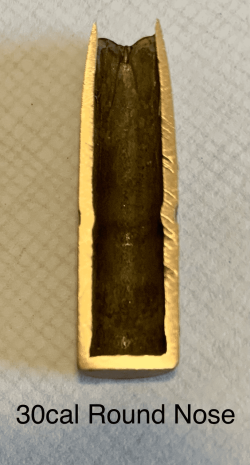I'm asking about Round Nose (RN) Core Lokt specifically.
When it comes to impacts under 2000fps, these (and other round nose bullets in general) have yielded significantly different, and significantly better on game performance than Spitzer (typical) type bullets in my experience
I should have clarified more on the Core-Lokts.
These, in general, are definitely a popular hunting bullet, but it's no secret that their popularity is mostly with your "average" hunter and used typically at close to medium distances. And I mean no offense by they or that there's anything wrong with that. Many very experienced hunters use them too and that's great.
If you wanted to hunt more often at medium, and definitely at long, distances you'd find these tend to struggle immensely with accuracy and terminal performance. After cross-sectioning them, you can get a better idea why that is.
First off, the core is only "Lokt" by a crude cannelure. These aren't an actual bonded bullet. That said, the cannelure is placed pretty much in the center of each bullet and it's allowed the jacket to slightly un-swage from the core, and unevenly (areas circled in the pictures). The cannelure tends to create an uneven crimp into the core as well (what the arrows are pointing out).
All Core-Lokts, to my knowledge, are flat based as well. You can see that even the base is uneven in thickness. The round nose version is also very uneven at the opening of the jacket where the lead core spills over and is exposed.
All these inconsistencies, that when fired and spun at high RPMs, can or do result in the bullets inducing an imbalance in flight. The longer the flight (distance to target) the more out of balance the bullet becomes. It'll yaw like crazy and end up impacting untrue- sometimes even keyholing. I'm not saying that happens often, but I've seen it personally in more than one rifle abd with more than one variety of Core-Lokts.
I was surprised by the overall jacket thickness. They're definitely not the thickest jackets I've seen, especially with typical "hunting" bullets, but they're not that thin either.
To me, these are really just cheaply made bullets that'll get the job done if you're only hunting at distances typically 100 yards and in- which there are TONS of hunters out there that never shoot at an animal farther than 100 yards. They're nothing special, and they're definitely not to the quality a long range hunter should strive for, in my humble opinion. There are simply better choices out there for that.
When it comes to impacts under 2000fps, these (and other round nose bullets in general) have yielded significantly different, and significantly better on game performance than Spitzer (typical) type bullets in my experience
If at closer distances and impacting below 2000fps, yes they'll work great. My point I was trying to make was that they can be very challenging to get to shoot accurately at longer distances. A round nose is not an inherently high BC bullet though and it's not going to get too far in most cases by the time it gets to 2000fps or less.
The wide frontal area of a round nose will indeed produce more potential for expansion, and at lower impact velocities than your typical spritzer. That's true. I even run the 117gr Hornady round nose in my go-to rifle for hog hunting because most shots are close range where I hunt them and it's a great balance in regards to expansion versus penetration for them.
So to be clear, when accuracy at longer distances, as well as lower impact velocities isn't detrimental, a round nose can be a great option. There are indeed circumstances where they still excel. Like I've said, all bullets have merits and their own strengths and weaknesses.

